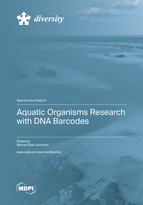Aquatic Organisms Research with DNA Barcodes
A special issue of Diversity (ISSN 1424-2818). This special issue belongs to the section "Phylogeny and Evolution".
Deadline for manuscript submissions: closed (31 March 2022) | Viewed by 63443
Special Issue Editor
Interests: freshwater zooplankton; systematics; DNA barcoding; zoogeography; eDNA
Special Issues, Collections and Topics in MDPI journals
Special Issue Information
Dear Colleagues,
Since the original proposal to DNA barcode all eukaryotes (Hebert et al. 2003), DNA barcoding has become the standard method for specimen identification and species discovery. To date, more than 12,000 papers employing DNA barcoding have been published. However, in the case of aquatic invertebrates, fewer than 300 papers have been published. This is a relatively low total when compared with other groups, such as insects (more than 1000 publications). It is clear that DNA barcoding studies on aquatic animals have just begun. Some problems with the amplification of standardized genes and the development of primers have impeded these studies, as have challenges in sample collection, fixation, and preservation. However, new methodologies that can help to solve these problems have recently been developed. DNA barcoding of aquatic flora and fauna is of much importance due to the multiple applications of good libraries for the detection of exotic species, biomonitoring, and food security. This Special Issue will cover any aspect of DNA barcoding of aquatic organisms related to biodiversity, conservation, and applications. We welcome all contributions related to understanding diversity in both freshwater and marine environments.
Prof. Dr. Manuel Elias-Gutierrez
Guest Editor
Manuscript Submission Information
Manuscripts should be submitted online at www.mdpi.com by registering and logging in to this website. Once you are registered, click here to go to the submission form. Manuscripts can be submitted until the deadline. All submissions that pass pre-check are peer-reviewed. Accepted papers will be published continuously in the journal (as soon as accepted) and will be listed together on the special issue website. Research articles, review articles as well as short communications are invited. For planned papers, a title and short abstract (about 100 words) can be sent to the Editorial Office for announcement on this website.
Submitted manuscripts should not have been published previously, nor be under consideration for publication elsewhere (except conference proceedings papers). All manuscripts are thoroughly refereed through a single-blind peer-review process. A guide for authors and other relevant information for submission of manuscripts is available on the Instructions for Authors page. Diversity is an international peer-reviewed open access monthly journal published by MDPI.
Please visit the Instructions for Authors page before submitting a manuscript. The Article Processing Charge (APC) for publication in this open access journal is 2600 CHF (Swiss Francs). Submitted papers should be well formatted and use good English. Authors may use MDPI's English editing service prior to publication or during author revisions.
Keywords
- DNA barcoding
- eDNA
- Aquatic organisms
- Biodiversity
- Global warming effects






